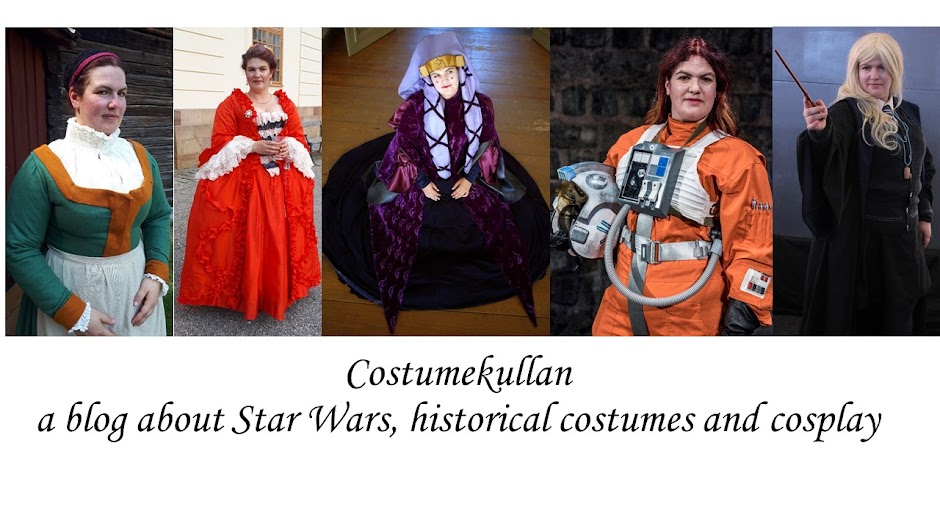Over the wulsthaube I want to make a goldembroidered cap. Since it's going to be embroidered I can't make it with a veil that I just wrap around the wulst.
Marlein has made this kind of cap, and she also has good documentation on that these kind of caps existed. Now I did try to follow her instructions but I didn't quite understand them, but thankfully I have asked her about some of the steps. A big difference for me though is that the headwear that I want to copy has a very distinct angle of the cap down at the cheek.
I can't just make the front edge continue all the way back to the neck and fasten it there, it needs to keep its position by itself. In thatway it's more similar to the 18th century caps that I've done a few of, but unlike them I didn't want to construct the cap from several parts. I wanted the cap to be just one piece of fabric.
I started draping just a rectangular piece of fabric over the wulst. I like working with rectangular pieces as much as possible, since from what I've seen people back in history tried to avoid cutting a fabric to shape as much as possible. It was impossible to get that angle at the cheek without cutting it though.
This was the starting point after a first evening of draping. The front tha goes around the face is smaller than the back that goes over the wulst. I stll had a problem with too much fabric at the bottom side though. I tried to cut away piece by piece, but in the end I cut too much and had to start over with a new test fabric.
In the end I got quite far away from a rectangular piece. The front edge also had to be curved, to lie flat around the face. Now I had a working pattern, so I cut out the linen that I would use for the cap.
And then I realised that it would have been easier to just mark the pattern, but keep the fabric square until I had done all the embroidery. Sometimes I don't think things through. I decided to go ahead and finish this cap anway. It would be a good test article, and it's always good to have another cap, after all there is a lot more use for a plain linen cap than a goldembroidered one.
The front of the cap is lined with a piece of heavy cotton, since it was supposed to have embroidery in ot it was needed for stabilization. The pieces are joined at the front edge, but the cotton lining is just hemmed and loose in the back. The short sides of the cap, that meet at the neck, ar then sewn together. Now you have a kind of fabric tube that you can put over the wulsthaube.
Then it's a matter of pleating the fabric into the back so that it looks nice and even, pin all the pleats into place.
There will be a bit of a tail hanging down, this can be cut off when you are finished.
Sew the pleats into place when you are happy.

Then I took the bottom of the tube, where I had the center seam, and folded that piece up over the fabric to cover the end of the pleats. My suggestion is to take the cap off the wulsthaube at this stage. I didn't and I manged to sew the cap to the wulsthaube and had to rip it up and redo it.
Now here is where I'm a bit disappointed. I felt that the fabric going over the top of the wulst was too short, so I had to make that rectangular piece reach up higher than I wanted to cover the edge of the fabric in the middle. For my next cap I'm going to make the top longer, but not the sides, so that I can avoid this. I also want my cap to go fairly far down the neck, since I have a lot of hair that I need to hide properly. To keep the cap in position I have added two pieces of linen tape, that are sewed on just where at the back end of the lining piece. I did this since I didn't want any visible lacing holes or ribbons. The tape can be tied and tucked under the cap as well.
This is the side view of the cap. I can have the fabric be a bit tighter just at the top of the wulst, but otherwise I really like it.
And this is what it looks like turned inside out.
Now I have cut out the linen, but kept it as a square, for my fancy cap. Unfortunately I didn't have any more cotton canvas to use as lining, so I'm going to try with just a heavier linen. I am waiting for my goldwork supplies to arrive. They are the first time with this project that I have suffered COVID19-related delays. The seller has been upfront with the delays though and my package has been shipped, so I can only hope that it arrives in the coming week.










.jpg)


























